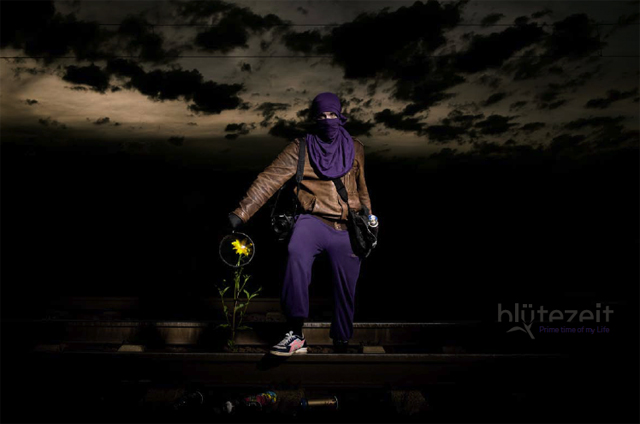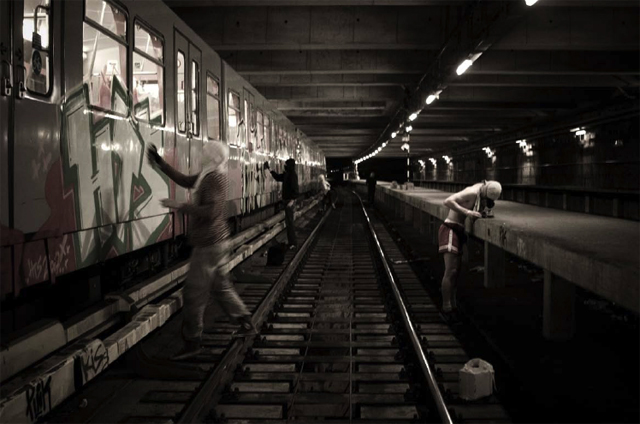Although it’s present everywhere, on buildings, in trains and even in contemporary pop culture, graffiti is still somewhat concealed in our society. Blütezeit (Prime Time of my Life), a photo art and documentary by German photographer and former Graffiti artist Nils Müller provides unique insights into this secretive subculture and amazing shots of this mystic scene. We caught up with him to look even further behind the scenes
(German version of the interview on page 2)
Where did you get the idea for this photo book and the behind the scenes angle?
I used to do graffiti myself and just took pictures of everything that seemed important to me. I just wanted to create something more visual for myself. At some point I had loads of pictures and wanted to establish a platform, so that I could have them lying around at home without it being illegal.
Why did you pick this angle?
It is an interesting, urban movement that hasn’t been examined from this angle before. Because of my past I have good contacts to the scene and I am much closer to the action than a normal reporter could ever be. I didn’t plan this project or do it with second thoughts in mind, it’s just my personal way of processing.
Would it be possible for an outsider to take photos like you did?
No. The sprayers wouldn’t be at ease. If someone they haven’t known for a long time came along asking for that, they would probably just laugh at him. They wouldn’t take just anyone along with them.
How did you get into the scene?
At 16, so 11 years ago. I’m from a small town where I had a friend who was into everything that was against the regime and he introduced me to graffiti. I did a lot of sketches and spent ages taking pictures of finished pieces on trains. You gain a lot of experience with people. The scene has a great network all over the globe, it’s very small but very intense. You can meet sprayers everywhere and exchange experiences with them, which is incredibly interesting and you learn a lot and progress very fast. Sometimes you also fall flat on your face but that’s part of the game too and you always learn something.
With graffiti the focus is mostly on the result rather than the genesis as in your book. How did the artists react to that?
There are so many platforms on the internet and in magazines that concentrate on the finished art pieces, but there’s only little new developments and progression. So the sprayers actually really liked my approach of giving more insights and showing what’s really important like the value of doing something together and what you feel during it.
Do you think it’s important to show this side as well?
I actually started this project just for myself, so I never really thought about that. Of course I’m pleased that it’s out in the open now, but I’ve never deliberately weeded it out. If someone wants to know more, they will find more info.

Your project brought you to different locations all over the world, what impressed you the most?
That’s difficult, many cities stunned me completely. I love Milan and Como, but that’s also to do with the fact that I have a lot of friends there and that I love Italian food. But I was also very stoked on Bangkok. They hardly have any scene at all there, so it was especially interesting to try that.
So it’s not as developed in Asia yet?
There is some development, but nothing revolutionary. That might still come though. Of course there is graffiti in more modern cities like Hong Kong for example. But in Shanghai, which is still a lot more traditional, there are hardly any sprayers at all, and if most of them moved there from somewhere in Europe.
Is that do to with the culture?
Well, with the connection. In Europe you always had access to graffiti, even back in the days when there was a lot less communication. If you were interested, you always found a way. That’s not given in many other countries.

Did you also get into dangerous situations?
There are so many stories… One of the most frightening happened in Lisbon, where I was following a sprayer around in a rather dodgy part of town. We tried to avoid a police patrol and turned around a corner where suddenly two dark and seedy guys appeared in front of us. They were shouting something in Portuguese and pulled out a gun. I got really scared and although my friend stopped, I heard some shots and ran for my life. This turned out to be a huge mistake as they were police in plain clothes, but I just wanted to get back to the patrol we saw previously. They also pointed their guns and shouted at me but I just threw myself under the police car and in the end they only took our details.
That’s one hell of a story.
There was another situation, where I almost got caught by a train. I had to cross the rails to take pictures and I swear I didn’t hear anything but suddenly a ICE came dashing towards me. One of the sprayers jumped at me and pushed me into the woods, it felt like in a bad movie. Those new trains are so quiet, it’s incredibly dangerous.
Is there a message you want to spread with your book?
(Thinks) No, not really (laughs). I just wanted to show my perspective. Of course it’s nice that also people who don’t really have anything to do with graffiti are interested. But for me this is art and I don’t want to exploit it.
Check out more of his work on nilsmuellerphotography.com.
We also have one copy of this amazing photo book to give away to one of our lucky readers – the first one to write an email to [email protected] with a good reason, why they want to win will get lucky. If you’re not as quick or lucky, you can still get it here here or try to win it on our competition page!
Auf der zweiten Seite gibt es das Interview auch auf Deutsch Woher kam die Idee zu diesem Bildband und gerade zur Idee, hinter die Kulissen zu blicken?
Woher kam die Idee zu diesem Bildband und gerade zur Idee, hinter die Kulissen zu blicken?
Ich hab selbst lange gesprüht und einfach alles, was mir wichtig erschien fotografiert. Ich wollte für mich selbst visuell einfach ein bisschen mehr darstellen. Irgendwann hatte ich einen Haufen Material zusammen und wollte mir eine Plattform schaffen, damit ich die Fotos legal daheim haben kann, das ist sonst ja auch immer ein Problem.
Und warum gerade dieser Ansatz?
Weil es eine interessante, urbane Bewegung ist und das Thema so noch nie bearbeitet wurde. Durch meine Vergangenheit habe ich wie gesagt gute Kontakte in die Szene und bin viel näher am Geschehen, als das ein normaler Reporter je sein könnte. Ich habe das Projekt auch nicht geplant oder aus irgendeiner Berechnung heraus angefangen, es ist einfach meine Art und Weise der Verarbeitung.
Wäre es auch einem „Außenseiter“ gelungen, solche Fotos zu machen?
Nein, da könnten sich die Sprüher wahrscheinlich gar nicht so locker machen. Wenn irgendeiner ankommen würde, den sie nicht schon länger kennen, würden sie ihn auslachen. Die nehmen ja nicht jeden einfach so mit.
Wie bist du denn zum Graffiti gekommen?
Mit 16, also vor 11 Jahren. Ich komme aus einer kleinen Stadt und hatte damals einen Kumpel, der so gut wie alles gemacht hat, was gegen den Staat war, durch ihn bin ich zum sprühen gekommen. Ich habe Skizzen gemacht, viele fertige Bilder fotografiert und mich damit auseinandergesetzt. Man macht unheimlich viele Erfahrungen mit Menschen. Die Szene ist auf der ganzen Welt vernetzt, zwar unheimlich klein gehalten aber wahnsinnig intensiv. Man kann sich überall auf der Welt mit anderen Sprühern austauschen, das ist total interessant, man lernt unglaublich viel und kommt total schnell weiter. Natürlich fällt man auch mal auf die Schnauze, aber das ist ja auch wichtig, daraus lernt man.
Sonst steht ja gerade bei Street Art und Graffiti eher das Resultat im Vordergrund und nicht wie bei dir die Entstehung. Wie haben denn die Künstler darauf reagiert?
Es gibt so viele Plattformen im Internet, in Magazinen und überall, die sich mit den fertigen Kunstwerken beschäftigen, aber fast keine neue Entwicklungen. Die Sprüher fanden es sogar ziemlich gut, dass auch mal mehr die Innensicht gezeigt wird und das, worauf es wirklich ankommt, also die gemeinsamen Aktionen und das, was man dabei spürt.
Glaubst du, dass es wichtig ist, auch diese Seite einmal zu zeigen?
Eigentlich habe ich dieses Projekt nur für mich gemacht, deswegen habe ich mir darüber noch nicht so viele Gedanken gemacht. Ich bin natürlich froh, dass man das jetzt auch nach außen tragen kann, aber ich habe das Thema bewusst nicht offen gelegt oder ausgemerzt. Wenn sich jemand mehr damit auseinandersetzen will, wird er auch mehr erfahren.

Dieses Projekt hat dich an die unterschiedlichsten Orte in der ganzen Welt geführt, was hat dich denn besonders beeindruckt?
Das ist schwierig, mich haben viele Städte echt beeindruckt. Besonders mag ich Mailand und Como in Italien, aber das liegt auch daran, dass ich dort viele Freunde habe und das Essen total liebe. Aber Bangkok hat mich auch total geflasht,. Dort gibt es eigentlich fast gar keine Szene, deswegen war es besonders interessant, das mal auszuprobieren.
In Asien ist das noch nicht so ausgeprägt?
Es entwickelt sich langsam, ist aber keine revolutionäre Bewegung oder so. Wobei das auch noch kommen kann. In moderneren Städten wie Hongkong gibt es schon ein paar Sprüher, aber in traditionelleren wie Shanghai oder so gibt es fast keine, außer sind aus Europa oder irgendwoher zugezogen.
Hängt das auch mit der Kultur zusammen?
Ja, mit der Verbindung. Als Europäer hatten wir schon immer Zugang zu Graffiti . Wenn du dich dafür interessierst hast, hast du immer etwas davon mitbekommen können, auch früher als die Kommunikation noch nicht so gut war. Das ist in vielen anderen Ländern einfach nicht gegeben.

Hast du auch schon richtig gefährliche Situationen erlebt?
Da gibt es so viele Storys… Eine der krassesten ist mir aber in Lissabon passiert, als ich nachts mit einem Sprüher in einer eher nicht so guten Gegend unterwegs war. Als wir einer Polizeistreife ausweichen wollten, kamen uns plötzlich zwei total zwielichtige Gestalten entgegen. Sie haben auf portugiesisch irgendetwas gerufen, eine Knarre gezogen und Schüsse abgegeben. Das waren zwar wahrscheinlich nur Luftschüsse, aber ich habe natürlich nichts verstanden sondern tierisch Angst gekriegt und obwohl mein Freund stehen geblieben ist, bin ich sofort abgehauen. Im Nachhinein hat sich das ziemlicher Fehler entpuppt, da das nämlich Zivilpolizisten waren, aber ich wollte einfach nur zurück zu den Polizisten, die wir vorher gesehen hatten. Die haben dann auch noch die Waffe auf mich gerichtet und mir irgendetwas entgegen geschrieen, nachdem ich mich unter das Polizeiauto geworfen habe, ging aber dann doch alles gut und sie haben nur unsere Personalien aufgenommen.
Das ist echt eine krasse Story.
Ich bin auch schon mal fast von einem Zug erwischt worden. Da musste ich ein kleines Stück über die Gleise gehen, um fotografieren zu können. Ich hab echt überhaupt nichts gehört, aber auf einmal kam ein ICE angrast und einer der Sprüher hat sich wie in einem schlechten Film auf mich gestürzt und mich von den Gleisen runter ins Gebüsch gezerrt. Diese neuen Züge sind so leise, das ist echt sau gefährlich
Hast Du denn eine Botschaft, die du mit dem Buch rüber bringen möchtest?
(Überlegt) Nein, wirklich nicht (lacht). Ich wollte einfach meinen eigenen Blickwinkel zeigen. Ich finde es natürlich schon schön, wenn sich auch Leute dafür interessieren, die mit Graffiti eigentlich nichts zu tun haben. Aber für mich ist das einfach Kunst und ich will das nicht ausschlachten.


